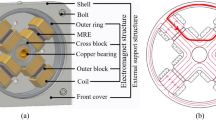Abstract
Mechanical systems with rotary machines or rotating elements experience torsional vibration, which may lead to an extreme damage and wear. Conventionally, to isolate these undesirable structural vibrations, passive elastomer or torsional dampers are used. However, these passive vibration isolators are not adaptive to varying oscillation frequencies in real time. Due to the need for a real time adaptability and controllable stiffness, the research and development of a smart material called magnetorheological elastomer (MRE) is of interest. This paper presents the mathematical modelling and development of MRE with its implication in torsional vibration control. Based on the model and through experimental studies, the properties of the MRE such as stiffness and transmissibility factor in regard to varying magnetic fields are investigated. The change in magnetic field is achieved by changing the amount of applied current. It is found out that the stiffness of MRE increases with increasing magnetic field and consequently modifies system’s natural frequency. This allows shift in the transmissibility curve to achieve minimum transmissibility factor in the applications involving varying frequency.








Similar content being viewed by others
References
Abdalla J, Petrovski J, Mohamedzein Y (2008) Vibration characteristics of a far-field earthquake and its shaking effects on Dubai emerging skycrapers. Paper presented at the 14th World conference on earthquake engineering, Beijing, China
Behrooz M, Wang X, Gordaninejad F (2014) Modeling of a new semi-active/passive magnetorheological elastomer isolator. Smart Mater Struct 23(4):045013
Chen L, Gong X-L, Li W-H (2008) Damping of magnetorheological elastomers. Chin J Chem Phys 21(6):567–572
Hoang N, Zhang N, Li WH, Du H (2013) Development of a torsional dynamic absorber using a magnetorheological elastomer for vibration reduction of a powertrain test rig. J Intell Mater Syst Struct 24(16):2036–2044
Kaleta J, Królewicz M, Lewandowski D (2011) Magnetomechanical properties of anisotropic and isotropic magnetorheological composites with thermoplastic elastomer matrices. Institute of Material Science and Mechanics, Narvik, pp 1–4
Li W, Zhou Y, Tian T (2010) Viscoelastic properties of MR elastomers under harmonic loading. Rheol Acta 49(7):733–740
Li Y, Li J, Samali B (2012) A novel adaptive base isolator utilising magnetorheological elastomer. Paper presented at the 22nd Australasian conference on the mechanics of structures and materials
Li J, Li Y, Li W, Samali B (2013) Development of adaptive seismic isolators for ultimate seismic protection of civil structures. Paper presented at the SPIE smart structures and materials + nondestructive evaluation and health monitoring
Liao G, Gong X, Xuan S, Kang C, Zong L (2012) Development of a real-time tunable stiffness and damping vibration isolator based on magnetorheological elastomer. J Intell Mater Syst Struct 23(1):25–33
Mazza F, Vulcano A (2012) Effects of near-fault ground motions on the nonlinear dynamic response of base-isolated rc framed buildings. Earthq Eng Struct Dyn 41(2):211–232
Nagarajaiah S (2006) Structural control benchmark problem: smart base isolated building subjected to near fault earthquakes. Struct Control Health Monit 13(2–3):571–572
Opie S, Yim W (2010) Design and control of a real-time variable modulus vibration isolator. J Intell Mater Syst Struct. doi:10.1177/1045389X10389204
Popp KM, Kröger M, Hua Li W, Zhang XZ, Kosasih PB (2010) MRE properties under shear and squeeze modes and applications. J Intell Mater Syst Struct 21(15):1471–1477
Ruddy C, Ahearne E, Byrne G (2012) A review of magnetorheological elastomers: properties and applications. Advanced manufacturing science (AMS) research
Spencer B Jr, Nagarajaiah S (2003) State of the art of structural control. J Struct Eng 129(7):845–856
Tárrago MG, Kari L, Viñolas J, Gil-Negrete N (2007) Torsion stiffness of a rubber bushing: a simple engineering design formula including the amplitude dependence. J Strain Anal Eng Des 42(1):13–21
Wachel JC, Szenasi FR (1993) Analysis of torsional vibrations in rotating machines. Paper presented at the proceeding of the twenty-second turbomachinery symposium
Weisstein EW (2009) Damped simple harmonic motion—critical damping. From MathWorld—a wolfram web resource, 1
Yang Z, Qin C, Rao Z, Ta N, Gong X (2014) Design and analyses of axial semi-active dynamic vibration absorbers based on magnetorheological elastomers. J Intell Mater Syst Struct. doi:10.1177/1045389X13519002
Zhang N, Hoang N, Du H (2008) A novel dynamic absorber using enhanced magnetorheological elastomers for powertrain vibration control. In: Advanced materials research, vol 47–50, pp 117–120
Author information
Authors and Affiliations
Corresponding author
Rights and permissions
About this article
Cite this article
Hashi, H.A., Muthalif, A.G.A. & Diyana Nordin, N.H. Dynamic Tuning of Torsional Transmissibility Using Magnetorheological Elastomer: Modelling and Experimental Verification. Iran J Sci Technol Trans Mech Eng 40, 181–187 (2016). https://doi.org/10.1007/s40997-016-0024-6
Received:
Accepted:
Published:
Issue Date:
DOI: https://doi.org/10.1007/s40997-016-0024-6




